

Saturn is considered by many to be the most beautiful object in the known universe. Anyone who has seen the planet through a powerful telescope will never forget the sight. A pastel-toned, yellowish globe, noticeably flattened at the poles, appears to float in the center of a delicate ring system as a simple but elegant jewel (Figure 10.1). In reality, Saturn is mostly a gigantic ball of gaseous hydrogen and helium surrounding a zone of liquid hydrogen and possibly a small rocky core in the interior. Saturn contains more than 100 times the volume of Earth but has a density less than that of water.
Saturn is the center of a large system of satellites. With its elaborate system of rings and multiplicity of satellites, Saturn resembles a miniature solar system. Thus, study of Saturn adds new insights to those gained from the examination of the Jupiter system and may ultimately reveal more clues about the origin and evolution of the Sun's system of planets. Although Saturn was visited by Pioneer 11 in 1979, our first detailed glimpses of the satellites were provided by the Voyager spacecraft as they flew through the system in November 1980 and August 1981. The Cassini probe went into orbit around Saturn in 2004 and monitored the planet and its moons until 2017, when it was sent on a deep dive into Saturn itself.
1. Saturn, somewhat smaller than Jupiter, is a large gas- and ice-rich planet well known for its ring system. It also has at least 60 satellites, most of which are icy.
2. Saturn consists principally of hydrogen and helium but appears to have an ice and rock core. The atmosphere has cloudy bands parallel to the equator and contains storms like Jupiter's but is not as colorful.
3. Saturn's ring system consists of a myriad of small ice particles in orbit around the planet. The rings are defined by small shepherd satellites and by resonances with larger satellites. The ice particles may be material that never accreted to form a moon or more likely may be the result of collisions in the satellite system.
4. Saturn has seven moons with diameters greater than about 400 km. The larger satellites are farther from Saturn.
5. Titan is larger than the planet Mercury and has an atmosphere rich in nitrogen. Titan has very few impact craters and its surface is young. It has rivers, seas, dunes, tectonic features, and possible icy volcanoes.
6. Six icy satellites, ranging from 400 to 1500 km in diameter, lack atmospheres and reveal surfaces modified by impact, tectonic, and volcanic processes. Enceladus, Tethys, Dione, and perhaps Rhea had extended thermal histories, indicated by young plains. The period over which their interiors remained warm may have been extended by tidal heating, particularly in the case of Enceladus. In addition, each of these bodies has large fractures or rifts, suggesting that each body cracked, perhaps while cooling. Mimas and Iapetus are impact-dominated bodies.
The table of physical and orbital characteristics (Table 10.1) summarizes some numerical information about Saturn, the sixth planet from the Sun. Saturn shares many general characteristics with the other three large planets of the outer solar system. It is the second largest planet, with a diameter of about 80 percent that of Jupiter, and ten times that of Earth. Because of its composition (rich in hydrogen and helium), Saturn has the lowest density of all the planets, even less than that of liquid water. Like Jupiter, Saturn has a large magnetic field, generated deep within its interior, and a rapid rotation rate. Its rapid spin (a day is only about 10 hours long) causes the fluid planet to bulge at the equator and flatten at the poles. The diameter at Saturn's equator is 13,000 km greater than the diameter measured through its spin axis. Saturn lies twice as far from the Sun as Jupiter and actually radiates more energy from its interior than it receives from the far distant Sun.

Saturn has a marvelous system of at least 62 (as of 2018) orbiting moons and a multitude rings (Table 10.2). In fact, Saturn has more moons greater than 100 km in diameter than any other planet. The satellites range from moons the size of Mercury to ring particles smaller than sand grains. Most of the moons consist mainly of water ice, with lesser amounts of silicate rocks, and even smaller, but significant, quantities of methane and ammonia ice.
Saturn has about the same composition as the Sun and the solar nebula from which the solar system formed some 4.6 billion years ago. Hydrogen is the most abundant element and helium is next. Other elements---oxygen, iron, neon, nitrogen, and silicon---make up most of the remaining 2 percent. Its internal structure must therefore be dominated by different forms of hydrogen, forms that are stable at the high temperatures and pressures in the deep interior. However, there is still much uncertainty about the internal structure of Saturn and the other outer planets.
Most models of the internal structure of Saturn are similar to that shown in Figure 10.2. The cloud zone forms a thin envelope that is only 0.l to 0.3 percent of the planet's radius. Small crystals of ammonia (NH3) in the the upper cloud layer give Saturn its distinctive yellowish color. With greater depth, hydrogen gas gradually changes to liquid. In this zone the hydrogens are bound to one another to make molecules.
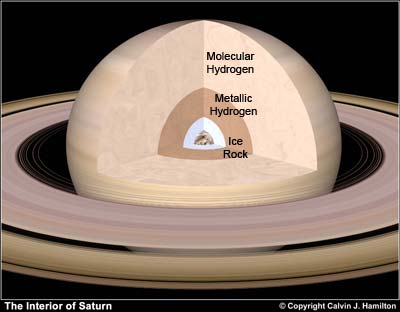
A significant transition occurs at a depth of about 30,000 km (half the radius of the planet), where molecular liquid hydrogen (H2) becomes metallic liquid hydrogen (H+ in which the molecules are split apart and the atoms are stripped of their outer electrons). The metallic hydrogen zone in Saturn is much smaller than that in Jupiter because of the lower pressure and temperature in smaller Saturn. As for Jupiter, the magnetic field of Saturn is probably caused by convection in the metallic hydrogen zone.
A second transition marks the change between the metallic hydrogen zone and the ice-silicate core, which is about 15-30 times as massive as Earth. Most of the iron, silicon, and other heavy elements together with much of the water, ammonia, and methane ices are separated because of their density and concentrated in this central core.
Saturn radiates about 2.5 times as much heat as it receives from the Sun. It was first assumed that this heat was generated by slow graviational compression, like that emitted from Jupiter. But this process doesn't produce enough heat to match the observation. Some other process within Saturn must be generating this excess heat. Perhaps, helium is separating from the liquid metallic hydrogen, releasing energy in the process. If part of the helium forms droplets and rains down to deeper levels, it would release enough heat by its fall and loss of gravitational potential energy to produce the excess heat. Apparently because of this sort of internal differentiation, the upper atmosphere of Saturn is depleted in helium compared to Jupiter and the Sun. Saturn's upper atmosphere has a concentration of about 3-11% helium (by volume) compared to 8-12% in Jupiter's atmosphere. Diamonds may also be in the upper part of the planet and rain down to lower levels. As unusal as this sounds, it may be happening in all of the gas giants.
Saturn's atmosphere is roughly similar to Jupiter's but the patterns of circulation are more obscured and muted because of a lack of contrast and a layer of overlying haze. This gives Saturn a soft, velvety appearance, subduing the color in its atmospheric patterns. At close range the haze appears more tenuous, however, and with computer enhancement of the Voyager photographs, a wealth of detail can be seen (Figure 10.3). The most prominent features on both Saturn and Jupiter are narrow, contrasting bands that circle the planets parallel to their equators. On Saturn the velocity of the winds in these bands is enormous, moving up to 1500 km per hour (15 miles per min or 900 miles per hour). They are traveling about four times as fast as the equatorial clouds of Jupiter, which makes Saturn's clouds the fastest in any planetary system.
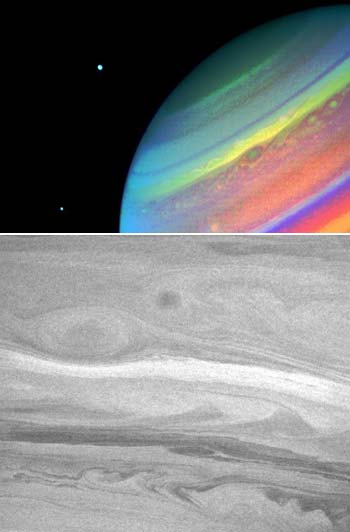
At higher latitudes, where wind speeds are lower, warm air rising from the interior can break up to form large circular storm systems with complex eddies (Figure 10.3). These appear on the photos as a variety of oval spots ranging in color from white to brown and red. The smaller eddies may be short-lived and last only a few days but the larger features may persist for a year or more. The largest storms on Saturn are the oval spots but they are substantially smaller than those on Jupiter. In addition, there are ribbonlike jet streams (Figure 10.3).
One of the most curious aspects of Saturn's atmosphere is the giant hexagon centered on the north pole. The entire hexagon changes color with the seasons, from blue to brown. At the very center, is a giant spinning blue vortex.
What could cause such powerful winds and create the swirling storm and jet streams? Unlike Earth, Mars, Venus, and probably Titan, whose atmospheres are driven by solar energy, the rapid winds and atmospheric motion on Saturn are caused as heat from the planet's interior is transferred to the atmosphere. The rain out of helium from the upper atmosphere could be the source of this extra energy.
Since the rings of Saturn were discovered by telescopic observations almost 400 years ago, they have amazed and intrigued astronomers, who strained at the eyepieces of their telescopes to glimpse fine details of these magnificent structures. Now that we have seen them up close through the eyes of sacecraft, they are even more astonishing and we are perhaps as surprised as the first people who saw them. Even with the explosion of our knowledge about them, the rings remain not only one of the most beautiful features in the heavens, but also one of the most scientifically challenging.
The rings of Saturn consist of billions of particles, ranging in size from the finest dust grains to large boulders 10 meters or more in diameter. Judging from their brightness and densities, the particles are probably made of water ice. Each particle moves in its own independent orbit and at its own independent speed. Each can be considered as a separate satellite, but the particles are concentrated in a thin region in Saturn's equatorial plane, giving the appearance of a solid disc (Figure 10.4).
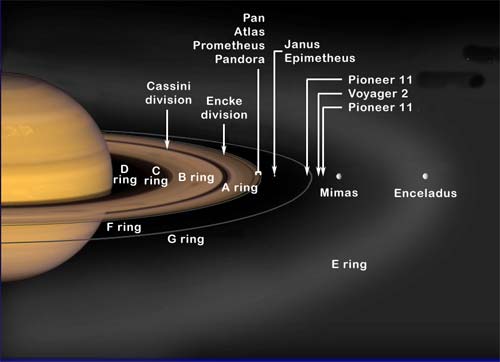
The main ring system extends from about 7000 km above Saturn's atmosphere out to the F ring, a total span of 74,000 km. It lies much closer to the planet than any of the major satellites. In fact, the bulk of the rings lies less than one planetary radius away from the surface of Saturn. Measurements made by instruments on the Voyager and Cassini spacecraft indicate that the main rings of Saturn are generally no more than a few hundred meters thick. (If scaled down to the size of a football field, the rings would be thinner than a razor's edge.) This is truly an incredible geometry and is responsible for the delicate beauty of the ring system. In terms of mass, the material in the rings is roughly equivalent to a satellite of ice 500 km in diameter.
Although ring material is organized into an extremely complex system of tens of thousands of separate ringlets, there are seven major sections. Each section is separated by a gap that is relatively devoid of particles or by an abrupt change in the spacing or sizes of the particles. The rings of Saturn were labeled in order of their discovery and so the labels have nothing to do with the rings' relative positions. Let us consider them in order outward from Saturn (Figure 10.4).
The ring particles are reddish, tan, or brownish and there are definite color differences between the rings. The color of pure water ice is white, so it is believed that the ring colors come either from impurities, such as iron oxides, or from structural damage to the ice crystals, caused by prolonged exposure to energetic atomic particles or by ultraviolet radiation from the Sun.
The innermost ring that we now know to orbit Saturn is the D ring. It extends from within 7000 km of Saturn's atmosphere to the inner edge of the C ring but is not visible in telescopic view nor in normal Voyager photos. Its existence was suspected from Earth-based photos but was never confirmed until long-exposure photographs from Voyager detected it.
The D ring consists of many very thin ringlets, which appear to have as intricate a structure as the more dense regions in the C and B rings. The material of the D ring is probably very fine-grained, possibly derived from the C ring leaking past a hypothetical satellite resonance that defines the inner edge of the C ring. It is probable that D-ring material spirals rapidly into Saturn's atmosphere because of the drag force on it (Figure 10.5).
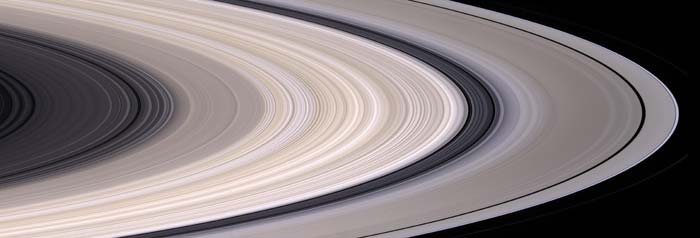
The C ring is the innermost of the classical rings of Saturn and can be faintly seen from Earth, even through a relatively small telescope. The C ring is distinguished by a regular ordering of light and dark bands (Figure 10.5 and 10.6). Two prominent gaps 200 to 300 km wide occur and add structural definition to the ring. Various measurements suggest that the particles in the C ring have a mean diameter of one meter, and that the particles are spaced about 20 m apart on the average. Probably a few objects with diameters of tens of meters to a kilometer or so are present. The C ring is deficient in very small particles when compared to the B and A rings.
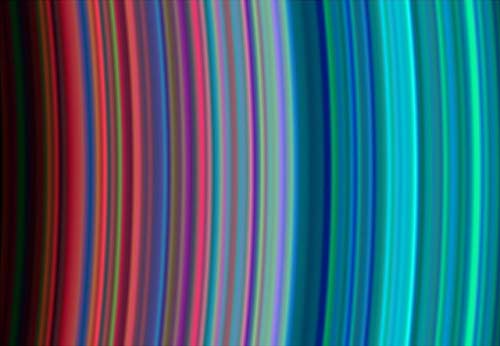
The B ring is the large central body of the ring system. It is separated from the A ring by the Cassini Division (see below) and from the C ring by a rapid transition to less dense, nearly transparent material. It is the brightest, widest, thickest and most opaque of Saturn's rings and probably contains most of the ring mass. Various measurements indicate that the B ring is no more than 2 km thick, the thickest in the main ring system. Data from the Voyager spacecraft and from radar observations further show that the most abundant particles are about 10 cm in diameter. The largest of the common particles are about 10 meters across. Dust-sized particles also are a significant fraction of the B ring.
The B ring displays an astonishingly detailed small-scale structure, consisting of thousands of fine bright and dark ringlets distributed without apparent regularity. These appear similar to grooves on a phonograph record and range in width down to the limits of the resolution of the cameras (Figure 10.7).
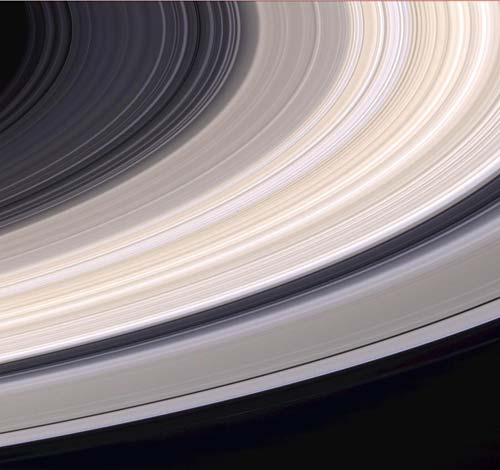
Unexpected features of the ring system are radial features, or spokes ( Figure 10.8). Most of the spokes appear in the central and most opaque part of the B ring. The spokes commonly are 10,000 km long, with widths ranging from 100 to 1000 km. Sequences of pictures taken of the spokes allowed scientists to develop a time-lapse movie showing growth and development of the spokes as the rings rotate. The inner section moves faster, so that the spoke becomes tilted and sheared with time and eventually disappears. Once formed, each spoke is visible for most of the 10 hours it takes for a particle to complete one orbital revolution. Meanwhile, new spokes form sporadically at new locations in the ring. Although there are many unanswered questions, the spokes are believed to be composed of a cloud of dust levitated above the ring plane by electrostatic forces similar to static electricity, which makes dust stand up on a record album (Figure 10.9).

The Cassini Division is the major gap separating the B and A rings. It was first noted in 1675 by Jean Cassini, a French astronomer. The inner edge (B-ring edge) is a sharp discontinuity at a 2 to 1 orbital resonance with the moon Mimas (where a ring particle orbits Saturn exactly twice for each orbit of Mimas). The outer edge is in resonance with Iapetus.
The Cassini Division is about 4000 km wide. The interior of the Cassini Division was once thought to be devoid of matter. However, it is seen in Voyager and Cassini images to contain a great deal of structure (Figure 10.10). It seems likely that the gaps within the Cassini Division were cleared of ring particles by small satellites 10 to 30 km in diameter embedded in the rings. However, since no such objects have yet been found, the repeated gravitational tug of Mimas on these particles to pull and push them out of the Cassini Division is more likely.
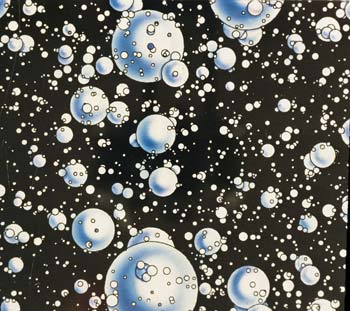
The A ring is much more uniform than the B ring and appears relatively free of fine ringlets. The inner edge is sharp and opaque like the B ring but most of the A ring is quite transparent. The outer edge is also sharp and well defined, probably because of gravitational interactions a small shepherd satellite. Particle sizes in the A ring span a broad range---from about 10 m in diameter down to micrometer-sized dust grains, which abound. In the A ring are several narrow ringlets due to orbital resonance as well as the prominent Encke Division.
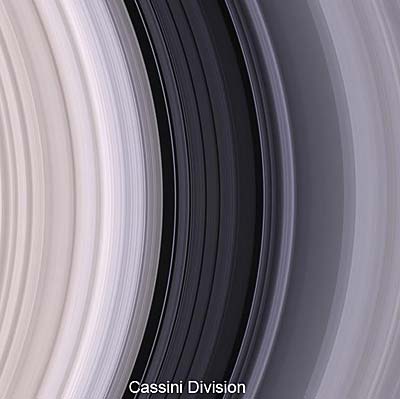
The F ring consists of a narrow band of material located some 4000 km beyond the outer edge of the A ring (main ring system) (Figure 10.11). The total width is only 700 km, so that on many photographs this ring is only a thin line. The narrow restriction of the F ring is thought to result from the gravitational focusing or shepherding of two small satellites, Pandora and Prometheus, on either side of the ring. Both the ring and the satellites are slightly eccentric in their orbits, and at times the inner satellite can approach within grazing distance of the ring. The F ring is thought to be composed of fine-grained particles of ice.

The photographs of the F ring provided many surprises. At moderate resolution, they revealed that the F ring is not uniformly bright all the way around, probably because of variations in concentrations of ring particles along the ring's orbit. At higher resolution, the Voyager 1 and Cassini photographs show gaps, kinks, warps, and knots in the F ring. The variations give the ring a "braided" appearance (Figure 10.11). But surprisingly, when Voyager 2 photographed five different areas of the ring, braids were found in only one small area. It thus appears that whatever created the braidlike structure is temporary or confined to small regions.
The origin of the gaps, channels, clumps, kinks, and braids in the F ring, appear to result from complex gravitational interactions with its eccentric shepherd satellites, Prometheus and Pandora (Figure 10.4).
Beyond the traditional system lies the E ring, which is scarcely more than a slight concentration of debris in the satellite orbital plane (Figure 10.12). It is best viewed when the ring system is seen approximately edge on. Observations made in 1980 and again in 2006 show that material extends out to at least eight planetary radii, thickening toward the outer edge. The density of the particles peak near the orbit of Enceladus. Only the E rings scatter light significantly, so many of its particles must be micron-sized, like those in Jupiter's ring. In fact, this amazing ring is probably made of debris erupted into orbit from volcano-like geysers on Enceladus (Figure 10.19).
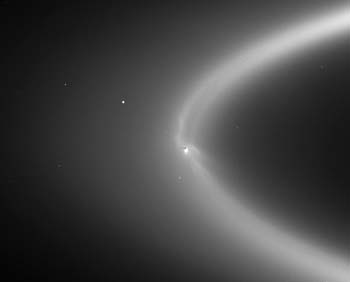
The recent discoveries of rings around Jupiter, Uranus, and Neptune, suggest that ring formation may be the rule, not the exception, for large planets. The presence of so many ring systems suggests that rings develop as part of the normal history of the outer planets. Three major hypotheses have been proposed to explain the origin of planetary rings: (1) tidal disruption of a satellite or comet, (2) large impact on a satellite, and (3) halted accretion.
The idea of tidal disruption was first proposed by a French mathematician, Edouard Albert Roche, in 1848. According to this hypothesis, Saturn's rings were generated when a single large body that came too close to the planet was fragmented into a myriad of pieces. The body may have been a comet that suffered a chance gravitational encounter. Calculations suggest that during the history of the solar system 10 to 100 large icy planetesimals or comets should have passed close enough to Saturn to be torn apart. As an example, in 1992, comet Shoemaker-Levy was ripped into at least a dozen fragments when it passed close to Jupiter. If its orbit had been slightly different, a new ring could have been born. Instead, the fragments of the disrupted comet crashed into Jupiter in 1994. Alternatively, if a small satellite moved too close to Saturn it could have been broken apart. This tidal disruption is a step further than the tidal massaging suffered by Io. Roche calculated that these tidal forces could exceed the cohesive gravitational forces of a liquid satellite, if the satellite came closer than about 2.5 times the radius of Saturn. This disruption threshold, or Roche limit, lies close to the outer edge of Saturn's main ring system. For rocky or icy satellites larger than about 40 km in diameter, the Roche limit is about 1.5 times the radius of the primary.
The second hypothesis holds that the rings formed from the primordial circumplanetary nebula from which the planet's satellites grew. Accretion began with cooling of the nebula and condensation of gaseous matter into solid grains, but (according to this hypothesis) the ring material did not grow into a large satellite. Accretion may have halted because of the gravitational effects of orbital resonances with small nearby satellites or the tidal deformation which prevented ring material from accreting. According to this hypothesis the rings are long-lived features.
The third hypothesis for ring formation is that a moon, or moons, in the ring system was completely fragmented by collision with another satellite or a large comet. The multitude of small particles went into orbit around Saturn as a cloud of debris. The particles eventually fell into a disk around the planet's equator. Collisions of particles in the rings made the particles even smaller. The multiring basins on Callisto and Ganymede and the giant craters on Tethys and Mimas show that impact by large bodies in the outer solar system did indeed occur. It is not strictly by chance that catastrophic collisions should occur in the area occupied by the rings. In addition, the gravitational field of Saturn focuses the trajectories of comets, so the number of potential impactors close to the planet is significantly greater than at greater distances. Studies of the variations in the rings suggest that they are changing on a short time scale. Some scientists conclude from this that the rings could not have survived for billions of years. The particles slowly spiral into the atmosphere of Saturn or toward a ring moon. According to this model, the present ring system is quite young, (between 10 and 100 million years old). Thus, the rings of Saturn would be the result of ongoing processes of creation by collisional disruption of small moons and eventual dispersal of the ring particles. The present small moons of Saturn may be the sources of new rings in the future. The principal problem with an impact origin for the rings is that it is difficult to form a moon as close to Saturn as the rings are today. Ring particles presumably would not accrete inside the Roche limit because of strong tidal forces.
In short, the origin and evolution of planetary ring systems remains one of the enigmas in the solar system.
The Saturnian moons are a diverse and remarkable group of icy worlds. Unlike the Jovian moons, there are no regular variations in size and composition with distance from Saturn. The satellite's dimensions range from the size of small asteroids to Titan, which is larger than the planet Mercury. Sixty-two satellites have now been identified (2018). Eighteen of the largest satellites are shown in Figure 10.13. Twenty-four of the moons are regular satellites (those that have nearly circular prograde orbits in Saturn's equatorial plane). The other satellites, including distant , do not orbit in the equatorial plane. Phoebe is in a retrograde orbit (meaning it moves in a direction opposite that of most satellites) with an inclination of about 150 degrees to the equatorial plane . Except Titan, which is in a class by itself, the six larger satellites of Saturn have much in common. All are intermediate in size (400 to 1500 km in diameter) and all are composed primarily of water ice. The smaller satellites are irregular objects and may include captured asteroids and fragments from intersatellite collisions.

The six larger satellites fall into convenient pairs that almost match their order outward from Saturn--Mimas and Enceladus (400 to 500 km in diameter), Tethys and Dione (approximately 1000 km in diameter), and Rhea and Iapetus (approximately 1500 km in diameter). Hyperion and Phoebe are smaller (irregular bodies with long dimensions of 250 and 220 km).
Various measurements, both from Earth-based observations and from spacecraft, indicate that the satellites are composed predominantly of water ice. All of the satellites for which we have estimates have densities of less than 1.9 g/cm3. For most of the satellites, a composition of approximately 30 to 40 percent rock and 60 to 70 percent water ice would match the estimated densities.
As noted before, there is good reason for ice to be a dominant substance in the outer solar system. When a gas whose composition is similar to that of the Sun is cooled under conditions believed to have existed in the early solar system, some oxygen in the gas will combine with silicon to form silicate rocks at relatively high temperatures. When the silicon is exhausted, a substantial amount of oxygen will remain. As temperatures continue to drop, the remaining oxygen will combine with hydrogen, the most abundant element in the gas, and will form water. At even lower temperatures, ices of methane and ammonia should also form. Also, the tendency for ice to lose vapor to space depends strongly on temperature. At a distance from the Sun less than that of the asteroid belt, a mass of water ice will evaporate in a relatively short time. At greater distances (Jupiter and beyond) a body of ice is stable for billions of years. Thus, ice is expected to be a major constituent in all bodies that accreted at low temperatures in the outer solar system.
One might anticipate that the small icy moons of Saturn would be of little geologic interest because of their cold origins, their primitive compositions, and their apparent lack of internal sources of heat. Ice, however, has a melting point far lower than that of rock, so relatively little heat is needed to melt the interior of an icy moon. Therefore, the moons of Saturn could develop some planetary dynamics (tectonism or volcanism) with relatively little internal energy. In addition, these moons probably contain small amounts of substances such as ammonia hydrates and compounds of methane and water. The interior of a body containing such material melts at a lower temperature than does one consisting of rock and water ice alone. Although this was known long ago, the new information about the small icy satellites of Saturn obtained from the Voyager and Cassini missions surpassed all expectations. Tethys, Enceladus, Dione, and perhaps Rhea show a surprising diversity of evidence for a long-lived source of internal heat that has been responsible for a complex history of tectonic and volcanic activity. In addition, observations suggest that there may be many combinations of energy sources (tidal heating, short-lived radionuclides, accretion of impact heating, and long-lived radionuclides) and compositions (low-melting-point condensate) that can result in internal melting and prolonged geologic activity in small, predominantly icy planetary bodies.
As the primary bodies in Saturn's miniature planetary system, these satellites provide the most important information about the origin and evolution of the Saturnian system. We discuss Titan first because of its unique properties and follow this by accounts of eight other satellites, in the order they occur outward from Saturn (Figure 10.14).
Saturn's giant moon Titan is considered by some planetary scientists to be the most intriguing moon in the solar system. With a diameter of 5150 km it is one of the largest satellites. In addition, Titan has long held a special allure as the only satellite known to have a substantial atmosphere. Its pressure and nitrogen-rich composition are similar to that of Earth. Unfortunately, the cloudy, smoggy atmosphere makes it very hard to see the surface of Titan. Consequently, the Cassini spacecraft used radar to construct relatively low resolution images that reveal a wealth of information for geologic study.
Titan is slightly smaller than Jupiter's Ganymede and slightly larger than Callisto. In many respects it could be considered their near twin. Their sizes are within 5 percent of each other and their densities are all between 1.8 and 1.9 g/cm3. (Titan is the densest of the moons of Saturn.) The similarities in size and density suggest that the bulk composition and structure of the three planetary bodies are probably similar, being composed of about 45 percent water ice and 55 percent silicate rock. Because of probable heating during accretion, some planetary differentiation seems very likely, so Titan's interior probably consists of a rocky core surrounded by a mantle of ice that may once have been liquid. However, Titan is very different from Ganymede and Callisto in that it has an atmosphere. Why? The answer is probably that Titan formed in a colder part of the solar nebula than Ganymede and Callisto and managed to incorporate ices of methane (CH4) and ammonia (NH3) into its bulk composition. These ices probably did not condense near Jupiter because it was too warm. With planetary differentiation, a fraction of these compounds escaped by outgassing from the interior to form an atmosphere, which Titan could hold because of its relatively large mass and consequent large gravitational force. Therefore, it seems that with only a small amount of methane and ammonia ice, Titan developed an atmosphere and evolved differently than Ganymede and Callisto.
Titan's atmosphere is composed mainly of nitrogen (N2) with as much as 10% methane---what we call natural gas---and traces of the more complex hydrocarbons and molecular hydrogen. Although we might have expected more methane in the atmosphere on frigid Titan, it appears that much of the methane is trapped in some kind of sink on the surface. Some of it is methane ice, but a more exciting discovery by Cassinni was that liquid hydrocarbons flow and pond on the surface. These liquids consist of methane along with other dissolved constituents. The atmospheric temperature and pressure lie near the triple point of methane (the point at which methane can co-exist as a solid, a liquid, and a gas). Thus, a situation somewhat like that on Earth, with methane assuming the role of water. A hydrocarbon cycle of clouds, rain, rivers, glaciers, and oceans might play a role in shaping Titan's surface (Figure 10.14). Other important features discovered by Cassini include huge equatorial dunes, potential volcanic features, and mountains. Moreover, like some of the satellites of Jupiter, Titan is only sparsely cratered and may have experienced tidal heating to keep it warm and volcanically active for billions of years after it first formed. Titan is periodically distorted by tidal forces because its orbit around Saturn is not completely circular. However, detailed calculations of its thermal evolution suggest that tdal heating would contribute less than 10% of Titan's internal heat. Perhaps, instead, the large size of Titan and radioactivity in its rocky core have kept Titan warm enough to be continually resurfaced.
As shown in Figure 10.14, the atmosphere of Titan is layered. A multilayered haze merges into a darker hood over the north pole, but such a mantle is not present at the south pole. In addition, the atmosphere in the southern hemisphere is light, with a well-defined boundary at the satellite's equator. The northern polar region is darker than the neighboring areas.
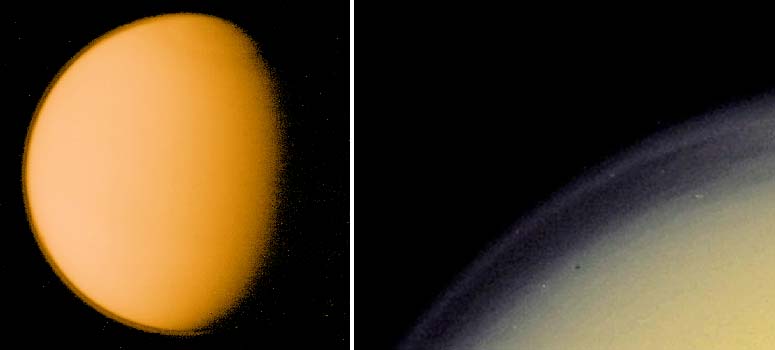
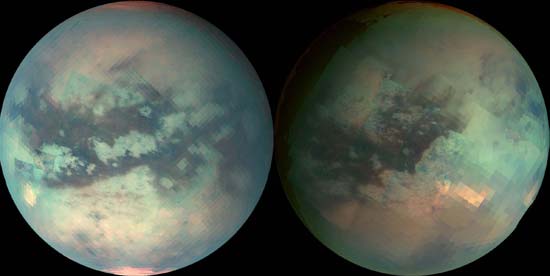

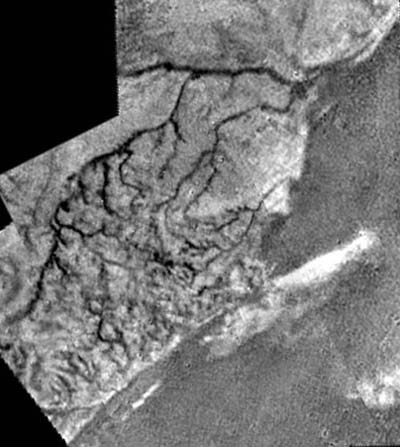
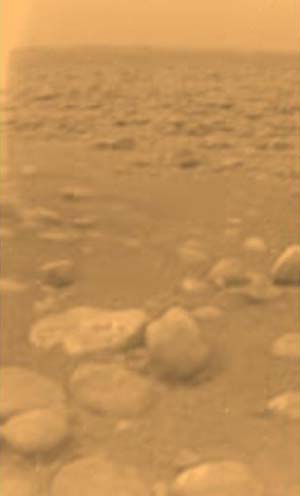
A theoretical cross section of Titan's atmosphere is shown in Figure 10.15. Above 400 km is a layer transparent to visible light in which ultraviolet radiation is absorbed. Next are several thin, high, haze layers; below them is a thick smog layer between 200 and 300 km above the surface. This smog consists of tiny aerosol particles composed of hydrogen and carbon. It is presumed that these particles have been aggregating into larger particles and falling to the surface over the history of Titan. They may have accumulated into a gooey deposit hundreds of meters thick. Methane clouds and methane rain may occur below an altitude of 40 km but are unconfirmed. The temperature at the surface is estimated to be about 94 K (-180°C), while the pressure is 1.5 times that of Earth. Nonetheless, the mass of the gas above each square meter of surface on Titan is about 10 times more than on Earth, because it takes more gas to exert similar pressures at the low gravity of this satellite.
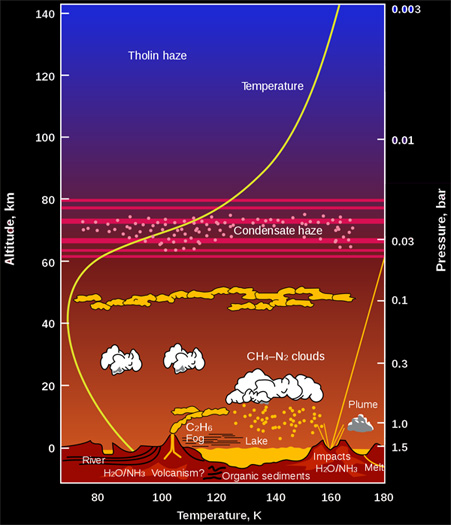
The dynamics of the atmosphere could involve the continuous formation of a multitude of large, complex organic molecules. When methane in the atmosphere is exposed to ultraviolet sunlight, its molecules lose one or more of their hydrogen atoms. These molecule fragments combine with other carbon compounds to form the more complex hydrocarbon aerosols called tholins. In the process, some hydrogen is released and may escape into space. The hydrocarbons ultimately precipitate and accumulate on the surface where they may be mobilized by the wind to make dunes. Atmospheric methane is renewed by evaporation from surface liquids or frosts and by outgassing from the interior.
Studies of Titan's fascinating atmosphere may reveal a few clues about the formation of complex hydrocarbons on planetary surfaces, such as those that led to the evolution of life on Earth. On both worlds several organic molecules were produced from the interaction of sunlight with volatile fluids. On Earth these molecules became complex and developed the ability to reproduce themselves. The large quantities of organic materials on Titan make it a most interesting place to study organic chemistry.
With a diameter of only 392 km, Mimas is the smallest and innermost of the major satellites that orbit Saturn, but was known from telescopic observation before the twentieth century. This small, icy body has only a thousandth the mass of Earth's Moon and a hundred-thousandth the mass of Earth. Its small size is significant because of what it might tell us concerning planetary evolution. Before the exploration of the outer solar system it was generally believed that the main source of heat in a planetary body was the decay of radioactive elements in the body's interior. Thus, the dynamic history of a planetary body, which is governed by the generation of heat, depends on the quantity of radioactive elements balanced against the loss of heat, which in turn is governed by the surface area to mass ratio. One would therefore assume that larger bodies (especially those made of silicate rock) would generate more heat, but lose it at a slower rate, than smaller bodies (especially those made of ice). They would thus be more likely to melt and remain hot longer and to develop an active tectonic system. For example, Earth's Moon and Mercury are each less than half the diameter of Earth and have long been geologically inactive. Mars is over half the diameter of Earth and has been moderately active volcanically throughout its history. These ideas suggest that a tiny icy moon such as Mimas would be an inactive sphere of ice that would not have changed (because of internal heat) since it formed.
This generalization holds for Mimas. It is less than 400 km in diameter and composed mostly of ice (density, 1.4 g/cm3). Its surface is heavily cratered, and there is no evidence that volcanism or resurfacing of any type has occurred since the early period of intense bombardment (figure 10.16). Many impact craters are old and severely degraded. Rayed craters have not been recognized, possibly because of the high albedo of the satellite's surface and the ease with which ejecta could escape into orbit about Saturn. Most of the craters are bowl-shaped and are sharper and much deeper than craters of comparable size on the Moon or on the large icy satellites of Jupiter. This is probably a natural result of the extremely low gravity field of this small body. The unique depth of craters on Mimas could also be influenced by the fact that Mimas is cold enough to prevent ice flow and isostatic rebound. Craters greater than 20 km in diameter have rudimentary central peaks.
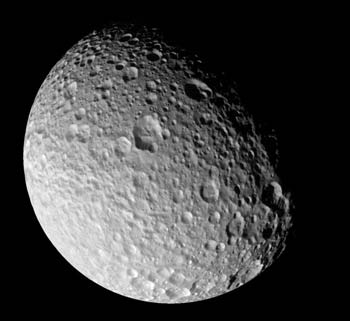
Because it rotates once for each revolution it makes about Saturn, Mimas always keeps the same face toward Saturn. This sort of spin-orbit coupling has evolved for all of Saturn's large satellites, with the possible exception of Titan. As a result, Mimas and the other tidally locked satellites have leading faces (the side facing forward with respect to orbital motion) and trailing faces or hemispheres.
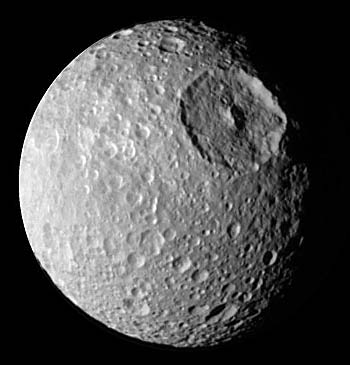
Because it rotates once for each revolution it makes about Saturn, Mimas always keeps the same face toward Saturn. This sort of spin-orbit coupling has evolved for all of Saturn's large satellites, with the possible exception of Titan. As a result, Mimas and the other tidally locked satellites have leading faces (the side facing forward with respect to orbital motion) and trailing faces or hemispheres.
The most striking feature on Mimas is a giant crater (130 km in diameter), nearly centered on the leading hemisphere. The image of this crater, dubbed Herschel, first appeared on the television screen as an enormous Cyclopean eye staring out into space, giving Mimas a bizarre appearance (Figure 10.18). (Yet, there was also a sense of deja vu. The resemblance to the Death Star spaceship from the movie, Star Wars, is uncanny.) The very size of the crater seems improbable. How could Mimas receive such an impact and survive? The crater rim is steep and sharp, appears to be little modified by superposed craters, and is evidently younger than most of the rest of the surface. The crater walls have an estimated average height of 5 km and parts rise more than 10 km above the crater floor. An enormous central peak 20 to 30 km in diameter at its base rises to a height of 6 km above the crater floor. This crater, which is about one-third the diameter of the satellite, must have been produced by the impact of a body approximately 10 km across. For a body the size of Mimas, which is weakly bound by its own gravity, this is very nearly as large an impact as could occur without breaking Mimas apart. A larger projectile would have shattered the cold and brittle satellite. If an earlier Mimas had been blown apart by one such impact the debris would probably remain in a narrow band where once the orbit of the satellite had been. Gradually the debris should reaccrete by mutual gravitational attractions to form a new moon. Comparisons with the size of craters on neighboring moons suggest to a few scientists that disruption may actually have happened---possibly several times.
In addition to craters, the surface of Mimas is scarred by a number of long narrow troughs (Figure 10.18). The most conspicuous troughs trend northwest and are as much as 90 km long, 10 km wide, and 1 to 2 km deep. Some are straight and may represent deep-seated fracture systems. Others are less regular and may consist of chains of coalesced craters. Geologists speculate that Mimas was nearly broken apart by the impact, which produced the large crater on the opposite side of the satellite, and that the shock wave that traveled through the satellite produced the large fractures.
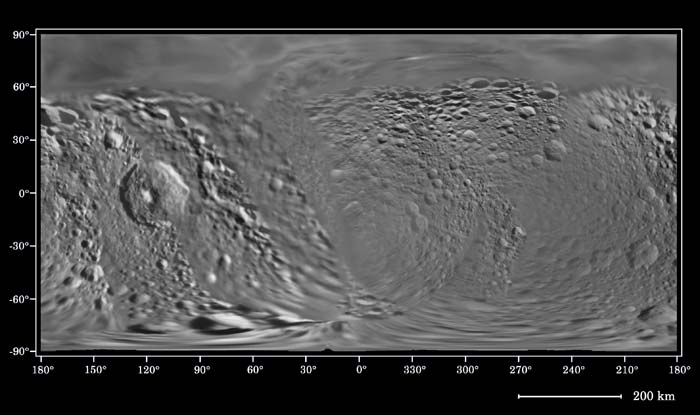
With its small size, Mimas is expected to be frozen all the way through; with no source of internal energy, it has probably remained essentially unchanged since the giant crater was formed billions of years ago. In fact, Mimas is so small that it may never have become internally differentiated. Accretion may have only raised its internal temperature less than 100 K, well below the point at which water ice melts. The interior of Mimas may thus consist of an intimate mixture of ice and rock.
In terms of size, Mimas and Enceladus are in the same class (392 versus 500 km in diameter); the next largest pair, Tethys and Dione, are an order of magnitude more massive. Before the Voyager encounter, scientists therefore expected Mimas and Enceladus to be similar---both being primitive, small, inactive spheres of ice. They could hardly have been more wrong. Voyager 2 came within 100,000 km of Enceladus and provided excellent images with resolution of about 2 km. As it turns out, Enceladus is remarkably different from Mimas. It is without question the most geologically active satellite of Saturn, and its surface contains a wide diversity of crater-free terrains, probably implying that resurfacing occurred within the last 100 million years or so.
As seen in Figures 10.19 and 10.20, the surface of Enceladus can be divided into several provinces, each characterized by different landforms and different geologic histories. At least five terrain types are recognized based on crater populations and other surface features.
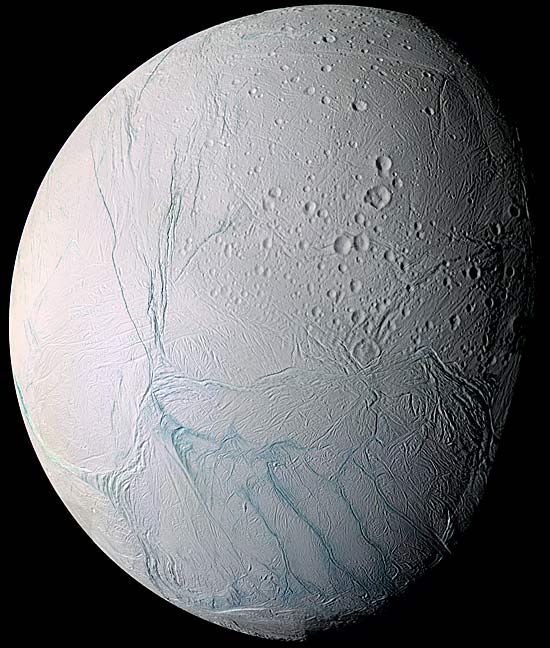
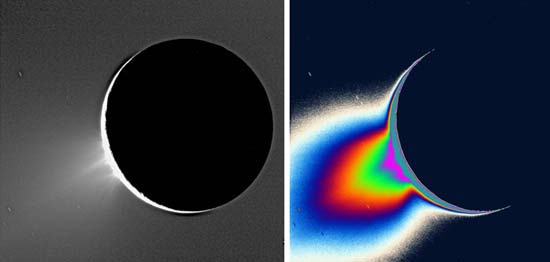
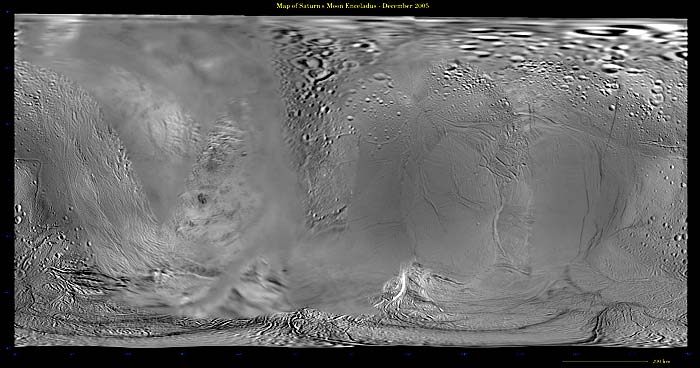
Cratered Terrain. The oldest surface on Enceladus is the cratered terrain, which covers most of the northern hemisphere. The craters are typically bowl-shaped, with sharp rims, and many larger ones have central peaks. From inspection of Figure 10.19, it is obvious that the crater frequency is not nearly as dense as that on Mimas (or Dione, Rhea, Tethys, or Iapetus). Impact craters up to 35 km in diameter are abundant, but there are no larger craters and the craters are not densely packed together. Based on this crater frequency, even the most densely cratered terrain may be younger than the period of intense bombardment.
Two types of cratered terrain have been identified on Enceladus. One, located near the terminator in Figure 10.19, is characterized by craters 10 to 20 km in diameter that are highly flattened and subdued. The other has craters of the same size, but the original topography is preserved. The craters are deep, and the bowl-shaped rims rise high above the crater floors. Apparently the thermal histories of the two regions have been different. A thermal event is postulated for the younger cratered terrain in which the icy crust was plastic or even liquid within 10 to 20 km of the surface, causing the craters to be altered by plastic flow and relaxation much as we have seen on other icy bodies.
Cratered Plains. South of the cratered terrain several regions are plains on which craters 5 to 10 km in diameter are sparsely distributed. In this area the crater frequency is only one-third that of the older cratered terrain. Between the craters are large areas that lack impact structures larger than 2 km in diameter.
Smooth Plains. A third major province, an area in which the dominant landform consists of an open pattern of rectilinear grooves (Figure 10.20), is called the smooth plains. Two types of smooth plains are recognized: (1) the area to the southwest, in which craters 2 to 5 km in diameter are very sparsely distributed over the surface, and (2) the area to the northeast, which is essentially free from craters and must be younger.
Ridged Plains. The ridged-plains province is the youngest terrain on Enceladus; it is distinguished by a complex of subparallel ridges, especially along its contacts with older terrain. Some ridges have a relief of more than 1 km and appear to be small-scale versions of the grooved terrain on Ganymede. A long corridor of the ridged-plains province extends northward from the equator along the 330 degrees longitude line almost to the north pole. It is along the margins of this corridor that we find the best evidence of crustal separation (where two large craters are bisected by the ridged terrain as though they were split by crustal spreading), but perhaps the truncated craters indicate down-dropping and flooding of grabens. Several stages in the development of the cratered terrain are also seen in this area.
Close study of the computer-enhanced image of Enceladus (Figure 10.19) reveals that an even more detailed subdivision of terrain types is possible and reinforces the fact that Enceladus has had a complex history during which there has been an involved sequence of thermal events and multiple stages of resurfacing parts of the planetary body.
Tectonic Features. Two styles of tectonic features are seen on Enceladus: (1) linear grooves that occur in the smooth plains are probably graben and indicate crustal extension and brittle fracturing; (2) the curvilinear valleys and ridges of the ridged plains resemble the grooved terrain on Ganymede, especially in the north polar region. On Enceladus there are double ridges with intervening valleys, simple grabens, and one-sided valleys (possibly fault scarps).
The grabens suggest normal faulting of a thin, brittle lithosphere, accompanied by extrusion of water or ice slush as an exotic form of volcanism to form the surrounding plains. The concentric patterns of ridges near the border of the smooth-plains province possibly resulted from convective upwelling. New crust formed in the center of the unit and caused compression along its margins. Voyager 2 did not reveal any ice volcanoes erupting and there are no obvious volcanic cones or calderas.
However, fissure eruptions of water and slush must have occurred many times on Enceladus, because the variety of landforms clearly indicates a continuing tectonic system, not an isolated event such as the impact of a large comet.
The big question concerns what heat source drives the geologic activity in Enceladus and has kept the interior molten and active throughout much of its history. Primordial heat inherited from accretion and differentiation cannot explain the geologic activity, because tiny Enceladus would have cooled and frozen solid within a few hundred million years after its formation. Radioactive heating also seems implausible, because such a small, icy body would have little uranium or other radioactive elements. The best explanation for a heat source might be heat from tidal stress induced by an orbital resonance with Dione. Enceladus is in a 2:1 resonance lock with Dione. That is, Enceladus orbits Saturn exactly twice for each orbit of Dione. Thus, Enceladus is forced into an eccentric orbit. This causes tidal bulges on Enceladus to alternately expand and contract, a process that generates heat. Such a process occurs on two of Jupiter's moons, Io and Europa, so that Io is continually being heated and is the most volcanically active planetary body in the solar system, and Europa has a young but cracked icy shell. Recent theoretical estimates of the amount of tidal heating experienced by Enceladus suggest that tidal heating may be adequate to soften the interior and perhaps melt water ice. In addition, if small amounts of ammonia are mixed with the water ice of Enceladus, the melting point of this mixture (173 K) would be about 100 K lower than for pure ice and could reduce the amount of heat needed to mobilize the icy crust.
Clearly, Enceladus joins Io in showing that radioactivity does not always dominate the thermal and geologic histories of planetary bodies in the solar system. Enceladus has only a hundred-thousandth the mass of Earth and yet it, nonetheless, may still be active geologically.
The best global view of Tethys, with a density of about 1.2 g/cm3 and a diameter of 1060 km, is shown in Figure 10.21. It is clear from this photo that Tethys, like several other Saturnian satellites, exhibits two major terrain types: (1) a heavily cratered terrain at the top of the photo (western hemisphere), which is extremely rough and hilly as a result of many large, highly degraded craters, and (2) a relatively smooth surface at the bottom of the photo (east, the trailing hemisphere) on which the number of impact craters is clearly smaller. A few craters on the smooth plains are large but most of the craters are quite small. The boundary between the two terrain types is not marked by a sharp change in color or tone, but the textures of the two surfaces are clearly distinct.
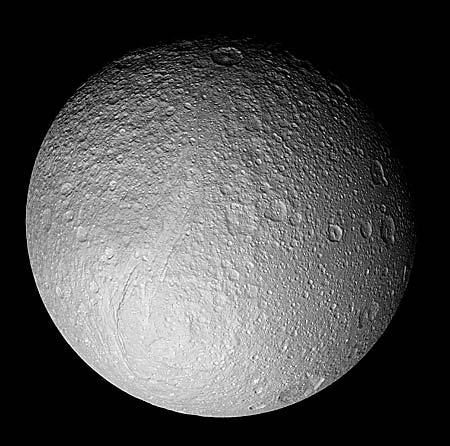
The plains to the east were probably produced by volcanic processes that generated slushy ice, which was extruded by fissure eruptions and flooded the older, densely cratered terrain, creating a new, smooth surface. Subsequent impact upon this new surface was relatively light and was dominated by smaller projectiles.
The images of Tethys reveal an enormous impact scar, named Odysseus, on the leading hemisphere, centered on 120 degrees longitude (Figure 10.22). The rim of Odysseus has a diameter that is 40 percent of the diameter (400 km) of Tethys itself. This structure looks like the large crater on Mimas, but the whole of little Mimas would fit into the great scar of Tethys, the largest and deepest crater in the Saturnian system. Odysseus was so large that it partly destroyed the curvature of the satellite. The original crater must have been very deep and its rim and central peak must have been high. Structural rebound of the crust has occurred, however, so the shape of the floor now matches the spherical shape of the satellite. Both the rim and central peak have collapsed and now appear subdued. Apparently the interior of Tethys was sufficiently warm during the early history of the satellite to allow such gravitational rearrangement (isostatic adjustment) of its surface features. The same adjustments have been made on large craters on Ganymede and Callisto, but apparently not on much smaller Mimas.
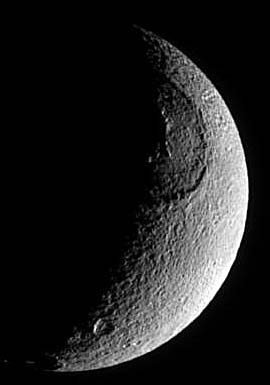
Tethys is also scarred with an enormous fracture system (Ithaca Chasma) centered on the Saturn-facing hemisphere (0 degrees longitude) (Figure 10.23). This huge trench extends as a continuous feature for 2000 km, almost three-quarters of the way around the satellite. The width of the valley complex is about 100 km and its depth ranges from 3 to 5 km. It is thus comparable in size (but not in detailed form) to the great Valles Marineris on Mars. The fracture system represents about 5 to 10 percent of the surface of Tethys. Its southern reaches are bordered by relatively smooth, uncratered plains. Some geologists suggest that the fracture system was produced because the surface of Tethys, which is largely water ice, cooled and contracted quickly compared to the still-warm interior. This contraction may have pulled the crust apart, forming a major rift zone. It is unclear why the vast stretch mark would take the form of a single regular girdle rather than a more complex fracture pattern.
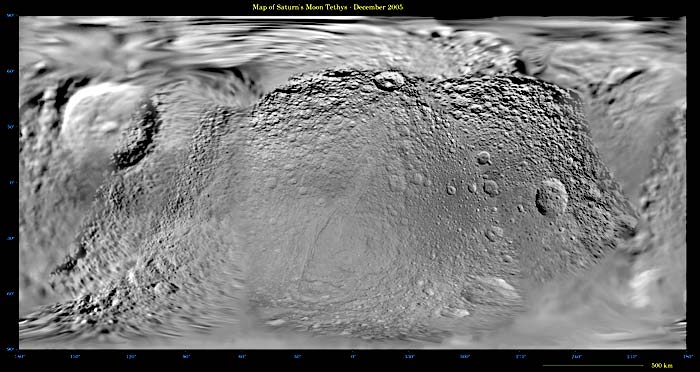
One other feature of Tethys deserves mention. As can be seen in Figure 10.23, parts of the surface are notably darker than others. For example, a dark zone trends essentially north-south near 270 degrees longitude. Boundaries are relatively sharp, and at first glance the dark marking appears to have been painted on the surface from an external source. This enigmatic feature has so far escaped adequate explanation.
Dione is about the same size as Tethys, with a diameter of 1120 km, but it has a distinctly higher density (1.5 g/cm3). Presumably Dione has a higher fraction of silicate rocky material and a correspondingly greater source of radiogenic heat. The radioctive, heat-producing elements are enriched in rock not ice. The value of 1.5 g/cm3 is consistent with a rocky core that comprises about one-third of the satellite's mass. In addition, Dione has a different global appearance. As seen in Figure 10.24, Dione shows some of the largest variations in surface brightness in the Saturnian system, second only to that of Iapetus. The trailing hemisphere is covered by a network of broad, wispy, bright markings. This type of surface feature are not seen anywhere else in the solar system. The strange bright markings, called wispy terrain, do not form a pattern typical of that produced by crater rays, but they closely follow regional fractures or faults. These markings are brighter than the brightest features seen on Jupiter's moons and are believed to be composed of water ice or frost, emitted from the interior of Dione along the fracture systems---a unique type of cryovolcanic ejecta. Perhaps the frost was carried upward by more volatile substances such as methane. Closeup views of Dione show that large old impact craters are crossed by the bright streaks indicating that the wisps formed after the period of intense bombardment.
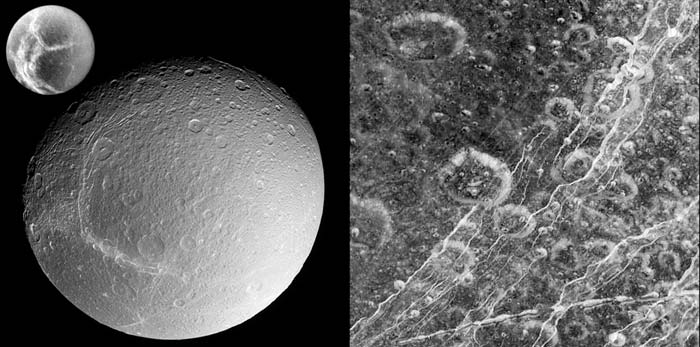
The leading hemisphere of Dione is intensely cratered and huge fractures extend across the surface for hundreds of kilometers (Figure 10.25). Nongeologists may become a bit bored to find another ball of ice scarred with craters and cut by deep canyons, but the specialist marvels at the diversity of craters and the events in the Saturnian system they record. The surface of the leading side of Dione consists of at least two terrains of contrasting topography (Figure 10.27). One, evidently older, is heavily cratered with both large and small impact structures. The craters range from small features near the limits of resolution to nearly 100 km in diameter. The large craters have well-developed central peaks and raised rims. There are also a few craters with bright radiating patterns probably representing clean ice thrown out as rays from impact. The other terrain is cratered with small impact structures but lacks larger craters. Why? The difference in the crater frequency of the two terrains represent distinct events in the satellite's history. The first period of Dione's history was dominated by impact from large bodies, probably material left over from the accretion of the solar system. Then parts of Dione were resurfaced; that is, a thermal event occurred in which internal melting produced liquid water and icy slush, which was extruded as fissure eruptions and buried parts of the already cratered surface. This layer of new material was thick enough to mantle and obscure the preexisting cratered terrain. Dione was then subjected to bombardment from smaller bodies, which modified the newly formed plains with small craters. Based on crater frequencies, these cryovolcanic smooth plains may be around 2 billion years old. About this same time, fractures formed over parts of the surface of Dione and were partly filled with extrusions from the interior. This could imply that Dione generated enough heat to produce a continual outpouring of material onto its surface over a sufficient period of time for the crateringrate to decline markedly. Perhaps the source of internal heat resulted from concentrations of radiogenic nuclides, which would be consistent with Dione's higher density and greater amounts of rock material.
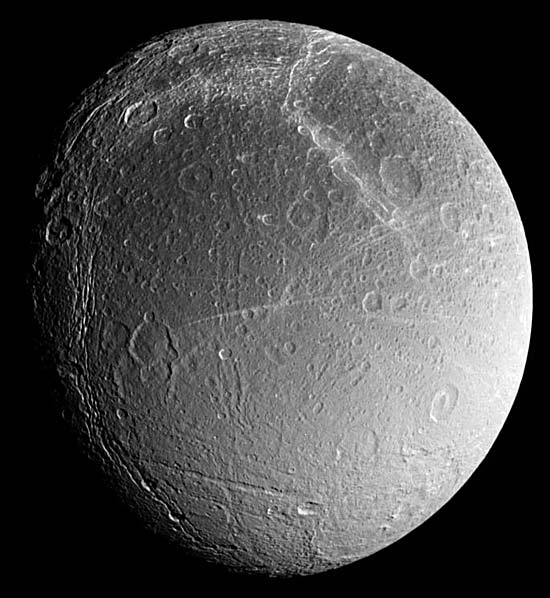
The absence of high-contrast boundaries between the older and younger terrains makes them harder to identify. The fundamental distinction between the two terrain types is in crater frequencies, not color or tone.
You can see from Figure 10.25 that Dione, like other icy satellites observed at close range, is nearly devoid of rayed craters. This is probably because the icy satellites are generally bright, which obscures fresh ray patterns.

Another major topographic feature occurs in the polar regions (Figure 10.26). In the north, a long, linear valley resembling a fault-bounded rift valley extends for nearly 500 km near 70 degrees north. The trough is part of a string of features that radiate from the rim of a large degraded crater. Much of the rest of the northern hemisphere is crisscrossed by a complex, branching valley system that extends toward the equator. These features indicate a significant period of crustal evolution and tectonic modification for Dione, possibly similar to that on Tethys.
Rhea is the largest of Saturn's airless moons (1530 km in diameter). Figure 10.27 shows a typical view of the north polar region and shows that the surface is dominated by craters and resembles the cratered highlands of the Moon and Mercury, except that the surface material is brilliant white ice rather than dark silicate rock. There are, however, significant visible differences in the cratered surfaces that are of great geologic interest. The principal difference is that the large, fresh craters on the Moon and Mercury are surrounded by well-formed ejecta blankets, whereas the craters on Rhea are not. Presumably Rhea's weaker gravity field is responsible. Given the same ejecta velocities as on the Moon, crater ejecta on Rhea would spread out five times farther than lunar ejecta and would thus form a much thinner ejecta blanket. If Copernicus, a large, fresh, rayed crater on the lunar maria, had formed on Rhea, its ejecta would have spread around the entire globe.
There are also notable differences between the craters on Rhea and those on Callisto and Ganymede. As you will recall from Chapter 9, the craters on the Galilean satellites are typically flattened and some have lost nearly all of their topographic expression, presumably because of viscous flow of the once soft icy crust. Rhea's craters, in contrast, are commonly sharp and rugged and have significant topographic relief. Evidently, Rhea's lower gravity and small diameter allowed rapid cooling and enabled its crust to support rugged crater morphology relatively unmodified by viscous flow of the icy crust.
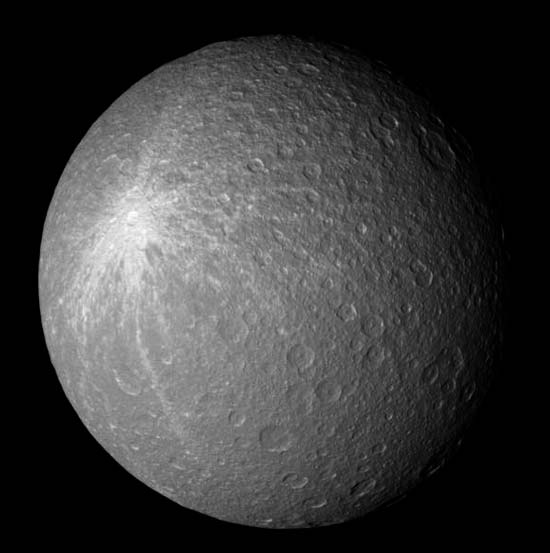
Many craters on Rhea have central peaks (Figure 10.28). Some craters are shallow, have subdued rims, and are generally degraded---showing their antiquity. Others have sharp, rugged rims, are unmodified by subsequent bombardment, and are relatively young. Curious bright patches, which may be fresh ice exposed as the result of slumping or minor impacts, are visible on some craters. It is also apparent from Figure 10.28 that many of Rhea's large craters have irregular outlines, often polygonal, suggesting that a weak rubble layer with zones of weakness, like the Moon's megaregolith, makes up the upper crust.
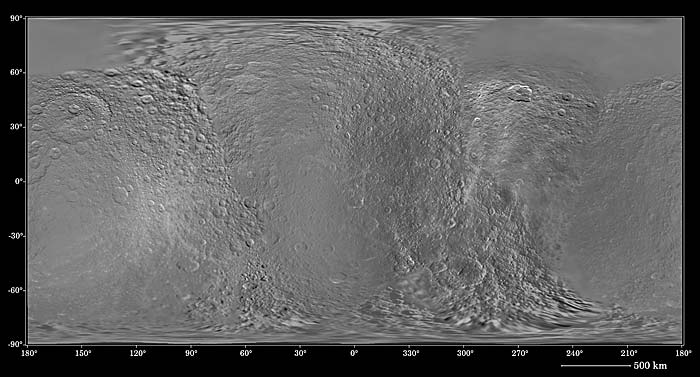
The shaded relief map of Rhea shows that in addition to the densely packed craters that scar the surface there is a complex network of narrow linear grooves or troughs. One example, almost 200 km long, is located between 290 and 300 degrees longitude at 30 to 40 degrees north latitude. Another lies at about 110 degrees longitude and 15 degrees north latitude. The straight fracture systems are typically oriented at 45 degrees to the parallels of latitude, which suggests to some researchers that the fractures could be part of a global tensional stress pattern. An origin by cooling of the outer portion of Rhea, like that discussed for the fracture system on Tethys, might be called on here as well.

The distant global view of Rhea shows contrasting markings on the leading and trailing hemisphere (Figure 10.29). Like Dione, the leading hemisphere is bright and bland, whereas the trailing hemisphere has bright, wispy streaks superimposed on a darker background. It has been suggested that the streaks were originally formed by frost and ice extruded along fractures and fissures over much of the surface on both hemispheres. Subsequently the leading hemisphere received many more impacts as it swept up debris in its orbital path. This pulverized and obliterated the striations on the leading hemisphere while the streaks were protected and preserved on the trailing side.
Iapetus circles Saturn in a lonely orbit nearly 3.5 million km from Saturn---almost three times as far away as Titan or Hyperion, the next closest satellites. In this far-distant reach of the early solar nebula, temperatures would have been low enough to freeze methane. Calculations based on the condensation model outlined in Chapter 2 suggest that materials condensed in this region of the early solar nebula would have yielded a mixture of water ice, silicate rock, and methane in a 55:35:10 ratio. The resulting planetary body accreting from such condensates would have a density of about 1.1 g/cm3, very close to what has been determined for Iapetus (1.1 g/cm3). Thus, if the interpretation of the satellite's density is correct, Iapetus may contains significant fraction of methane.
Only slightly smaller than Rhea, Iapetus has a diameter of 1470 km. However, it is not part of the regular system of Saturnian satellites in that its orbit is inclined 14.7 degrees from the equatorial plane. The other moons of Saturn all have nearly circular orbits and lie in the equatorial plane of the planet. Like other satellites of Saturn, Iapetus keeps the same face toward Saturn.
The most spectacular surface feature on Iapetus is the irregular patch of dark material that covers the leading hemisphere (Figure 10.30). Indeed, the principal dark region is centered almost perfectly on this face (Figure 10.31). The bright material has an albedo comparable to that of slightly dirty snow, whereas the dark material is similar to coal or soot. The only known planetary substances with albedos as low are carbonaceous materials such as those found in some meteorites.

One explanation for the dark side of Iapetus is that the dark material originated somewhere other than on Iapetus, perhaps from Phoebe (the largest moon beyond Iapetus), and swept up by the leading side of Iapetus. The color of Phoebe and the dark side of Iapetus are very similar in detail providing evidence for this hypothesis. Alternatively, both Phoebe and Iapetus may be covered by cometary debris which turns out to be similar to color and inferred composition.
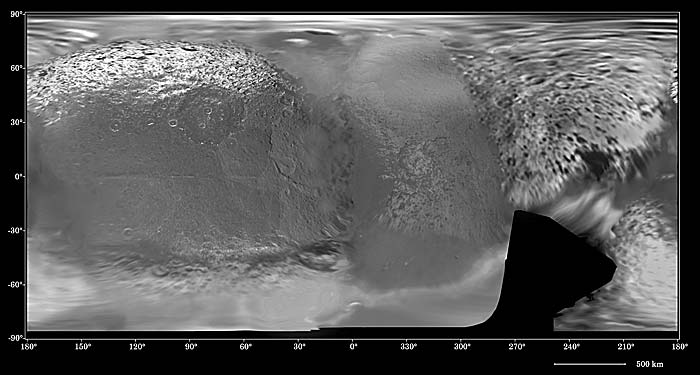
The bright hemisphere of Iapetus appears to be more heavily cratered than any of the other satellites of Saturn and is therefore considered to have the oldest surface. Most craters are of small to intermediate size. Large impact striations and fracture systems like those on Tethys and Mimas are not seen.
In addition to the seven principal satellites, Saturn controls a multitude of smaller satellites, ranging up to about 360 km across (Figure 10.32). Many are yet to be discovered. Aside from some data obtained from imaging, little is known about these objects. In particular, their masses are not all known, so their bulk densities cannot be calculated and their bulk compositions are uncertain. Perhaps the most interesting aspects about these small satellites are their orbits. Nearly all are remarkable in some way and provide new data on the complexities of the Saturnian system.

Phoebe. Phoebe (Figure 10.32) is one of Saturn's many outer moons. It is subrounded but still very jagged and heavily cratered. with a diameter of 220 km. Phoebe has a higher density than most (1.6 g/cm3) moons of Saturn. It is so small that it may never have heated up and differentiated. In addition, Phoebe has a very dark surface, with a reflectivity of less than 6 percent; it is soot black. The low albedo and color are similar to primitive comets. Impact crater walls and floors are not as dark, however. This leads us to believe that the dark material is just a coating or blanket on top of a brighter, icier interior.
Thus, Phoebe has little in common with the rest of the Saturnian satellites. It is dark and rockier; the others arebright and icier. Phoebe's orbit is inclined; the others lie in the equatorial plane. Phoebe's orbit is retrograde; the orbits of the other satellites are prograde. These observations have been used to suggest that Phoebe is a captured object from the outer solar system--perhaps from the Kuiper belt-- and was not formed in the same area as the icy satellites of Saturn.
Hyperion. Hyperion orbits Saturn between Iapetus and Titan. It is a small icy moon with an irregular shape. Larger than nearly spherical Phoebe, its major dimensions are about 370 by 290 by 230 km with angular features and facets as well as rounded edges (Figure 10.33). Its irregular shape suggests that it is a remnant of a larger body that was shaped by impact.
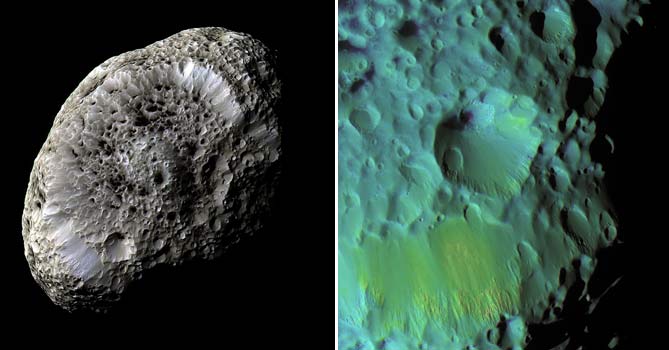
Several large impact structures ranging up to 120 km in diameter (with 10 km of relief) are visible on Hyperion. The surface is peppered with numerous craters 10 km in diameter and smaller. The irregular shape and cratered surface indicate that Hyperion may have the oldest surface in the Saturnian system.
The most interesting discoveries about Hyperion are its orbital attitude and peculiar spin. Hyperion appears to be tumbling on an axis that spins chaotically, but it lies nearly in the orbital plane. However, Hyperion's long axis is tilted about 45 degrees out of the plane of its orbit. These conditions are not the stable end products of tidal evolution, at least not in any simple gravitational relationship with Saturn. Two explanations seem possible. One is that Saturn has not had sufficient time to form a tidal lock on Hyperion. At Hyperion's distance from Saturn tidal effects are weak, and the apparent dynamic imbalance could be ancient. A second possibility is that it is a remnant of a satellite disrupted in a recent massive collision. The impact could have jolted Hyperion's orientation askew and there has not been enough time for it to reestablish orbital equilibrium.
The Lagrangian Satellites. It has long been known that a small object could share an orbit with a larger one if it stayed 60 degrees in front or behind the major body. These are referred to as Lagrangian points. Theoretically, five points are possible, but only two are stable in real planetary systems. Jupiter has two such groups of asteroids (known as the Trojan asteroids because the first one discovered was named Hektor) 60 degrees ahead and 60 degrees behind in its solar orbit.
Even Tethys has two Lagrangian satellites (Calypso and Telesto) which share its orbit (Figure 10.32). Dione has one, Helene; but, unlike Tethys, no satellite in a trailing position has been found yet.
The Lagrangian satellites of Tethys and Dione are irregular objects of apparent icy composition. They are 30 to 40 km long and may be fragments of a larger parent body.
The Co-Orbital Satellites. Two satellites, Janus and Epimetheus, have almost in the same orbit, and the motion of these two small moons is fascinating (Figure 10.34). The orbit of the slower object is just 50 km larger than that of the inner and faster-moving body. Once every four years the satellite in the inner and faster orbit catches up with its companion and they interact gravitationally. Since the space between the two orbits is less than the diameters of the satellites themselves, there is no room to pass; and, just short of collision, the two satellites attract each other gravitationally and exchange orbits. They then move slowly apart and the cycle starts over again. As far as we know this type of orbital motion is unique in the solar system.
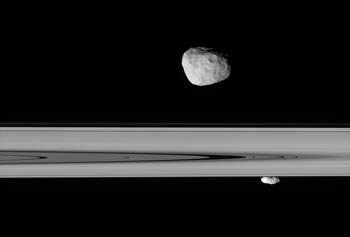
The co-orbital satellites, which measure 220 and 140 km in their longest dimensions, are the largest of the satellites inside the orbit of Mimas. Their densities are only about 0.7 g/cm3, lower than water ice (0.92 g/cm3). If they are made of ice, these moons must have bout 30% empty space, suggesting that they are porous rubble heaps. They are irregular objects and appear to be battered with impact structures. All of these data suggest that these small moons are fragments of a larger parent that was fragmented by an impact more severe than the one that caused the large crater on Mimas.

The Shepherd Satellites. Several small satellites orbit close to Saturn and are called shepherds because of their role in confining the ring particles to their proper orbits (Figure 10.32). Prometheus and Pandora bracket the F ring and their gravitational perturbations of the orbital paths of the ring particles may be responsible for the ring's kinky braids (Figure 10.11) . A particle escaping either inward or outward from the F ring will interact gravitationally with one of these "sheepdogs" and be "herded" back into line. Because of the gravitational focusing of these small satellites, the particles of the F ring are confined to a narrow band. Actually, the shepherd satellites of the F ring are nearly co-orbital, but their orbits are separated by about 2000 km, so there is ample room for them to pass once each month with no difficulty. The inner F-ring shepherd, Prometheus, is oblong, being about 140 km in its longest dimension. Pandora is fairly spherical. Both show small craters on their surfaces. (Figure 10.**)
The A-ring shepherd, Atlas, orbits just 800 km beyond the A ring and appears to keep the outer edge sharp and well defined. It is a small, oblong object just 30 km in its longest dimension (Fig. 10.**). Its tiny gravitational force prevents material from the outer edge of the A ring from drifting farther out and seems to establish an outer boundary for the entire ring system. It has a mysterious "flying saucer" shape. Another ring shepherds, Pan, has an even larger ledge than Atlas, making it one of the oddest moons in the entire Solar System (Fig. 10.*). The midriff bulges probably consist of icy ring particles that became graviationally attached to the shepherds.
Saturn and its entourage of moons and rings probably formed together, accreting from solids that condensed as a swirling Saturn-centered portion of the solar nebula cooled about 4.6 billion years ago. Saturn's massive atmosphere probably formed from the nebula when the planet's icy core grew large enough to trap the gaseous hydrogen and helium from the surrounding cloud. Three phases may characterize the gravitational contraction of Saturn: (1) an initial phase during which proto-Saturn was several hundred times its present size; (2) a collapse phase during which Saturn shrank to about five times its present size in about a year; and (3) a late phase during which Saturn slowly contracted to its present size over 4.6 billion years. Why isn't Saturn as large as Jupiter? Its icy core is almost as large as Jupiter's. Apparently, the nebula simply ran out of gas. During the T Tauri phase of the Sun's development huge volumes of gas were swept away. Perhaps, this gas was escaping while Saturn was trying to grow.
The rings and satellites with regular orbits are thought to be made of solids that condensed from a disk of gas and dust that originated near the end of the second phase. As Saturn formed, it may have become quite hot. Nonetheless, Saturn appears not to have been as warm as Jupiter at the stage when the satellites formed. All of Saturn's regular satellites are icy (some may even have ices of ammonia and methane), whereas the satellites that formed near Jupiter (Io and Europa) consist mostly of silicate rock, and those formed far from it have much more ice (Ganymede and Callisto)---evidence of a large thermal gradient centered on Jupiter.
After their collisional accretion and the formation of intensely cratered surfaces, the satellites of Saturn followed different histories. Titan, the largest of the Saturnian satellites, probably differentiated and outgassed an atmosphere of methane and nitrogen, which became methane depleted and now obscures the surface. Some of the other satellites may not have acquired enough heat during accretion to melt and differentiate. Mimas, Rhea, and Iapetus preserve ancient cratered surfaces that were fractured by impact or tectonic processes (Mimas and Rhea) or buried by dark debris (Iapetus). After the heavy bombardment that followed accretion, Dione, Tethys, and Enceladus were resurfaced with (cryovolcanic?) plains material, which covered and obliterated heavily cratered terrain. Subsequent collisions at reduced intensities produced less heavily cratered terrains that contrast with the older terrains on these bodies. These same satellites apparently fractured at some stage in their histories to produce large rifts or troughs---perhaps as a result of the cooling and contraction of their outer portions relative to their warmer interiors or because water ice expands as it freezes. Concurrently or subsequently to tectonism and resurfacing, material escaping from the interiors of Dione and Rhea created complex networks of bright streaks or wisps.
Among the satellites of Saturn, the thermal history of tiny Enceladus is unique. Tectonic disruption and volcanic resurfacing appears to have been continuous since the period of intense bombardment. The oldest terrain is only moderately cratered, and several generations of younger terrain types can be identified. Resurfacing processes by icy volcanism may be continuing today. The energy for extending the duration of the geologic development of Enceladus is probably the result of tidal interactions with Dione, with which it is in orbital resonance, and Saturn.
It is even possible that early collisions led to the complete collisional disruption of some satellites. It is important to remember that the concentrations and accelerations of impacting objects are controlled by Saturn's gravity field, so there may be a steep gradient in cratering rate from the outermost (low) to the innermost (high) satellites. The cratering rate on Rhea could have been about twice that of Iapetus and the rate on Mimas about 20 times that on Iapetus. According to this interpretation, from Dione inward, any large former satellite could have been struck at least once by a projectile with sufficient energy to fragment it. If disruption of the inner satellites occurred, the fragments reassembled by accretion. Dione and Tethys may have been disrupted and reaccreted once, Enceladus four times, and Mimas five times. The smaller satellites near the rings and the ring particles themselves could then be the products of a long and complex history of collisional disruption.
If we accept this hypothesis, we must consider the present Saturnian satellites to be reaccreted from the disruption of a system of larger satellites. It is speculated that impact from large comets (perhaps 200 km in diameter) could disrupt and fragment these original satellites. Most of the denser material would be captured by Saturn itself and reaccretion of the ice fragments would form the smaller satellites seen today. Titan was the only large moon to survive, probably because its orbit is far from Saturn and may have escaped the central focus of comet bombardment. Admittedly, this is speculative; the satellites may date from the epoch of Saturn's formation. We just don' know yet.
Obviously, these very different interpretations of the history of Saturn's satellites have important consequences for understanding the early history of the solar system. New spacecraft and new techniques of study will likely be required before the final answers are in. In the meantime, the Saturn system will continue to be the focus of scientific scrutiny.
1. Why might planetary rings be common but short-lived phenomena for the outer planets?
2. Compare the various possible modes of origins for planetary rings.
3. Describe the function of the shepherd satellites.
4. What are the principal differences between Titan and the rest of the satellites of Jupiter?
5. What is the evidence that the moons of Saturn consist mostly of water ice? Is this expected from our present understanding of planet formation from the solar nebula?
6. Why does Titan (like Earth) have an atmosphere rich in nitrogen when Saturn has an atmosphere rich in hydrogen and helium?
7. What is the significance of the differences between the small, icy moons Enceladus and Mimas?
8. How and why do craters on Mimas differ from craters of similar diameter found on the Moon?
9. Describe three ways in which large fracture systems can form on small icy satellites like those of Saturn.
10. Why is the amount of radioactive heating thought to be related to the amount of rocky, silicate materials in a planetary body? Would a chunk of pure ice have any radioactive elements?
11. Why do most planetary satellites keep one side pointed in the direction of their orbital movement? In what ways might the trailing and leading hemispheres of a Saturnian satellite be expected to differ? Can you cite any examples of such differences between hemispheres?
12. What characteristics of Iapetus make it unique among the Saturnian satellites?
13. Does a generalized geologic history for a small, icy body in the outer solar system exist? What factors create variations on this theme?
14. What is the evidence that Phoebe and some of the other outer satellites of Saturn are captured bodies that did not form around Saturn?
co-orbital satellite
Lagrangian points
regular satellite
retrograde orbit
rings
Roche limit
shepherd satellite